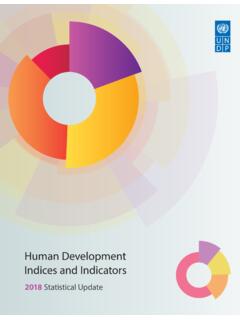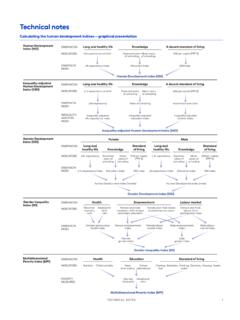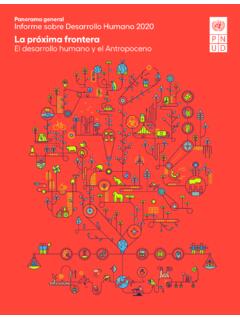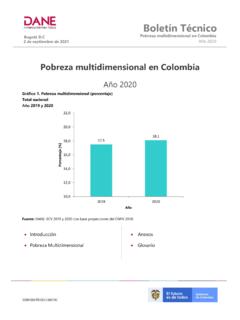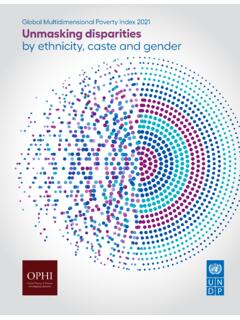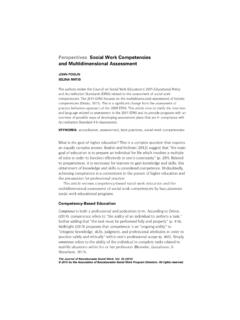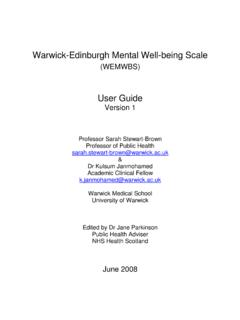Transcription of Charting pathways out of multidimensional poverty ...
1 OPHI. Oxford poverty & Human Development Initiative Empowered lives. Resilient nations. Charting pathways out of multidimensional poverty : Achieving the SDGs The team that created this report includes Sabina Alkire, Pedro Concei o, Cecilia Calder n, Jakob Dirksen, Maya Evans, Rolando Gonzales, Jon Hall, Admir Jahic, Usha Kanagaratnam, Maarit Kivilo, Milorad Kovacevic, Fanni Kovesdi, Corinne Mitchell, Ricardo Nogales, Anna Ortubia, M nica Pinilla-Roncancio, Natalie Quinn, Carolina Rivera, Sophie Scharlin-Pettee and Nicolai Suppa. Peer reviewers include Enrique Delamonica, Ivan Gonzalez de Alba, Gonzalo Hernandez Licona, Frances Stewart and Bishwa Tiwari. The team would like to thank the editors and layout artists at Communications Development Incorporated led by Bruce Ross-Larson, with Joe Brinley, Joe Caponio, Christopher Trott and Elaine Wilson.
2 For a list of any errors and omissions found subsequent to printing, please visit and Copyright @ 2020. By the United Nations Development Programme and Oxford poverty and Human Development Initiative Global multidimensional poverty Index 2020. Charting pathways out of multidimensional poverty : Achieving the SDGs OPHI. Oxford poverty & Human Development Initiative Empowered lives. Resilient nations. Contents Introduction 1 9 In 52 of the 71 countries with both multidimensional and monetary poverty data, the incidence of multidimensional poverty fell faster in absolute terms 13. Part I. The global multidimensional poverty Index 2 10 Overlaying trends in the incidence of national and international monetary and multidimensional poverty provides a fuller picture of a country's poverty Key findings 3.
3 Situation: Colombia, Pakistan and Sierra Leone 14. What is the global multidimensional poverty Index? 4 11 South Asia and Sub- Saharan Africa had the largest annualized absolute The global multidimensional poverty Index in 2020 5 reductions in multidimensional poverty 15. Trends in multidimensional poverty : Progress and challenges 5 12 Forty-seven countries are on track to halve multidimensional poverty by 2030, and eighteen are off track if observed trends continue 16. Projections of multidimensional poverty 12. 13 Under a conservative scenario of the impact of COVID-19 on school attendance and a moderate scenario of the impact on nutrition, simulations indicate that the Part II. The Sustainable Development Goals and the global increase in deprivations because of COVID-19 may set poverty levels back by multidimensional poverty Index 18.
4 Years, with an additional 490 million people falling into multidimensional poverty 17. Key findings 19 14 Sustainable Development Goals that link to the global multidimensional The wide scope of interlinkages 20 poverty Index 21. The MPI and immunization 22 15 Interlinked deprivations across 107 countries 21. 16 There is a negative correlation between immunization coverage and the The intersectionality of multidimensional poverty in education 25. incidence of multidimensional poverty 23. The MPI and the rural urban divide 27 17 The percentage of people who are multidimensionally poor and deprived in The MPI, climate change and the environment 28 child mortality is highest in Nigeria, which also has one of the lowest percentages of DTP3 coverage globally 24.
5 The MPI, work and employment 31. 18 In Democratic Republic of the Congo, Ethiopia, Nigeria and Pakistan the percentage of people living with a child who did not receive the third dose of Notes and references 35. the DPT-HepB-Hib vaccine is highest among multidimensionally poor people 24. Notes 36 19 Sub- Saharan African countries have the highest percentages of people who are References 38 multidimensionally poor and deprived in years of schooling and school attendance 25. 20 In Mali the mean years of schooling of adults older than 25 is higher for men than for women across all poverty groups 26. STATISTICAL TABLES. 21 In Haiti the differences in mean years of schooling between women and men 1 multidimensional poverty Index: developing countries 41.
6 Who live in rural and urban areas in different poverty groups are clear 26. 2 multidimensional poverty Index: changes over time based on harmonized 22 Of the billion people who are multidimensionally poor, billion people . estimates 44. percent live in rural areas 28. 23 The percentage of people who are multidimensionally poor and deprived in BOXES each indicator is always higher in rural areas than in urban areas 29. 1 Definitions for measuring changes in multidimensional poverty 6 24 In Kenya the impact of recent natural disasters is greater in provinces with 2 Reducing multidimensional poverty in Sierra Leone during the Ebola crisis 6 higher multidimensional poverty 30. 3 The global multidimensional poverty Index and the Sustainable Development Goals 20 25 The percentages of people who are multidimensionally poor and deprived in access to clean cooking fuel, access to clean drinking water and access to improved sanitation are highest in Sub- Saharan Africa 30.
7 FIGURES 26 The average contribution of environmental indicators to the multidimensional 1 Structure of the global multidimensional poverty Index 4 poverty Index differs significantly between rural and urban areas and across 2 Poorer countries with the highest initial multidimensional poverty Index values regions 31. and countries with low values tend to have slower absolute reduction rates 5 27 Child labour is more prevalent in countries with higher multidimensional poverty 32. 3 In Madagascar multidimensional poverty declined most slowly among children, 28 Higher employment in the agricultural sector is associated with higher even though they were the poorest age group 7 multidimensional poverty in Sub- Saharan Africa 32. 4 Some of the poorest countries in Sub- Saharan Africa achieved the fastest 29 A higher share of informal employment in nonagricultural employment is absolute reductions in multidimensional poverty 8 associated with higher multidimensional poverty 33.
8 5 Reductions in multidimensional poverty can be driven by improvements in 30 In countries with high multidimensional poverty a large share of the different indicators 8 population lacks any social protection 34. 6 Absolute and relative annualized reductions in multidimensional poverty 10. 7 Bangladesh, Lao People's Democratic Republic and Mauritania show a TABLE. pro-poor trend in reducing multidimensional poverty 11. 1 COVID-19 scenarios, projected global multidimensional poverty Index values, 8 Which country reduced each indicator fastest and when? 12 increases in the number of multidimensionally poor people, and length of setback 17. ii | GLOBAL multidimensional poverty INDEX 2020. Introduction The lives of poor people are an intricate balance; their steps out of poverty even more so.
9 Millions of daily labourers, herders and farmers eking out subsistence on rugged terrain have no access to clean drinking water and no electric light at home. Street vendors' children may be undernourished, and entire families illiterate. In tough times many children drop out of school. Improvements may come an electrification scheme, better water and sanitation, upgraded schools with lunch programmes, and good local health clinics. But conflicts, migrations, disasters and shocks also threaten. Launched in 2010 by the Oxford poverty and greater environmental threats. By detailing and Human Development Initiative at the the connections between the MPI and other University of Oxford and the Human Devel- poverty -related SDGs, the report highlights opment Report Office of the United Nations how the lives of multidimensionally poor peo- Development Programme for the flagship ple are precarious in ways that extend beyond Human Development Reports, the global the MPI's 10 component indicators.
10 multidimensional poverty Index (MPI) meas- The COVID-19 pandemic unfolded in the ures the complexities of poor people's lives, midst of this analysis. While data are not yet individually and collectively, each year. This available to measure the rise of global poverty report released 10 years after that launch after the pandemic, simulations based on dif- focuses on how multidimensional poverty ferent scenarios suggest that, if unaddressed, has declined. It provides a comprehensive progress across 70 developing countries could picture of global trends in multidimensional be set back 3 10 years. poverty , covering 5 billion people. It probes The firm hope is that it will not. As Amart- patterns between and within countries and by ya Sen observes, Britain during World War II.
